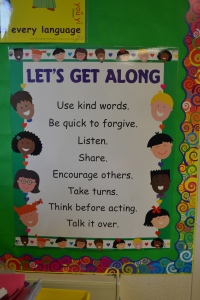Real World Business Advice Applied to Education
Teachers, how many times have we heard that we don’t work “in the real world”? We finish work at 3:00 p.m. every day, we have summers off, and schools are not results-oriented like businesses. Never mind that we take our work home with us (average teacher works 53 hours per week), or that we work on the weekends and in the summer, or that we earn less than people with similar educational attainment. But they’ve got us on that last point, right?
Wrong. Now first of all, we know that school-to-business comparisons fail because schools don’t have customers or products, because schools are not free to choose their mission or control key conditions for their work. They are not – and shouldn’t be – designed to divert profits away from core operations. That doesn’t mean that our work place is something other than the real world. It couldn’t be any more real for us or our students, and to suggest otherwise is an insult.
But then, it turns out that “real world” businesses actually succeed when they operate according to many of the same principles that are criticized in education. It’s like our critics have fabricated some imaginary world that they want to convince us is more real, because supposedly, in that reality, data, numbers, and spreadsheets trump all else, and the ability of managers to hire and fire based on results keeps everyone honest and working at their optimal performance level.
It’s not really that simple though. Just browse the business section of a bookstore, read some business management gurus, and you’ll find some important similarities between the best management ideas for businesses, schools, and even classrooms. Despite our differences with business, there are similarities in the better principles for working with people in complex social situations. And they’re not always so data-driven. And failure is an option – even a means of advancement.
Last summer I served up a Silicon Valley lesson for Arne Duncan, entreating him to recognize the virtues of the local business culture where I live and work. Prior to that, I wrote a series of blog posts about making school more like business (Parts One, Two, and Three). For anyone interested in the topic, I think there’s much for both sides to learn in order to advance more intelligent discussions about effective management for complex organizations involving actual human beings.
Today’s lessons come from the New York Times Business Section, March 18, 2012. Exhibit A: “Helping Managers See and Fix Their Flaws,” by Natasha Singer. It’s an article on evaluation, in a way. I expected that since this article was about business in “the real world” I would see the use of objective data. Instead, it turned out that a company called Minds at Work “guides executives through a step-by-step process of self-examination and gradual behavioral change.”
The article details how the company has helped clients become better managers by focusing on behaviors like delegating work, and attitudes like empathy. Not a single mention of an objective fact or figure in the article, but I did see plenty of descriptions of behaviors that would work perfectly in teacher evaluation. The practitioner identifies an area needing improvement. A coach provides observations and feedback. The practitioner tests assumptions, tries new approaches, and adjusts practice according to findings. The coach is not there to criticize the practitioner, and certainly not there to gather evidence that will go into dismissal proceedings.
One client of Minds at Work is the president of Decurion Corporation, a Los Angeles business that owns real estate and entertainment companies. His goal? “If I wanted to become more effective [with employees], I needed to go beyond sense-making and make more of a human connection.” In education, the aphorism that comes to mind is that students don’t care what you know until they know that you care. Handcuffing teachers and students with a scripted curriculum represents the institutional nullification of that principle.
So it turns out the Sunday New York Times actually has some useful advice for those of us in education. But if you want to see Exhibit B in this real world business lesson, you’ll have to come back tomorrow.



I was doing something darned close to what you describe 40+ years ago. It was called interaction analysis and provided the kind of coaching help you describe. How have we strayed so far from what worked to the pit we are in now? Here is a link to a description of interaction analysis: http://www.jstor.org/discover/10.2307/1475981?uid=3739856&uid=2129&uid=2&uid=70&uid=4&uid=3739256&sid=47698774208197